Applying System Thinking Tools: Analysis of BP Oil Explosion Risks
VerifiedAdded on 2024/05/14
|9
|2661
|100
Essay
AI Summary
This essay provides an analysis of the BP Deepwater Horizon oil explosion using system thinking tools and techniques. It begins with an overview of system thinking, highlighting key components such as objects, attributes, relationships, boundaries, and environmental influences. The essay then delves into the Deepwater Horizon incident, emphasizing the role of defective cement and engineering negligence as primary causes. The analysis incorporates cause mapping to illustrate the sequence of events leading to the explosion, including the initial well blowout, failed attempts to seal the leak, and the eventual construction of relief wells. The conclusion underscores the importance of system thinking in risk analysis and problem-solving within complex projects, while also noting the systemic failures and negligence that contributed to the disaster. The essay makes effective use of examples to show the real world impact of system thinking tools. This document is available on Desklib, a platform offering a range of study tools and resources for students.
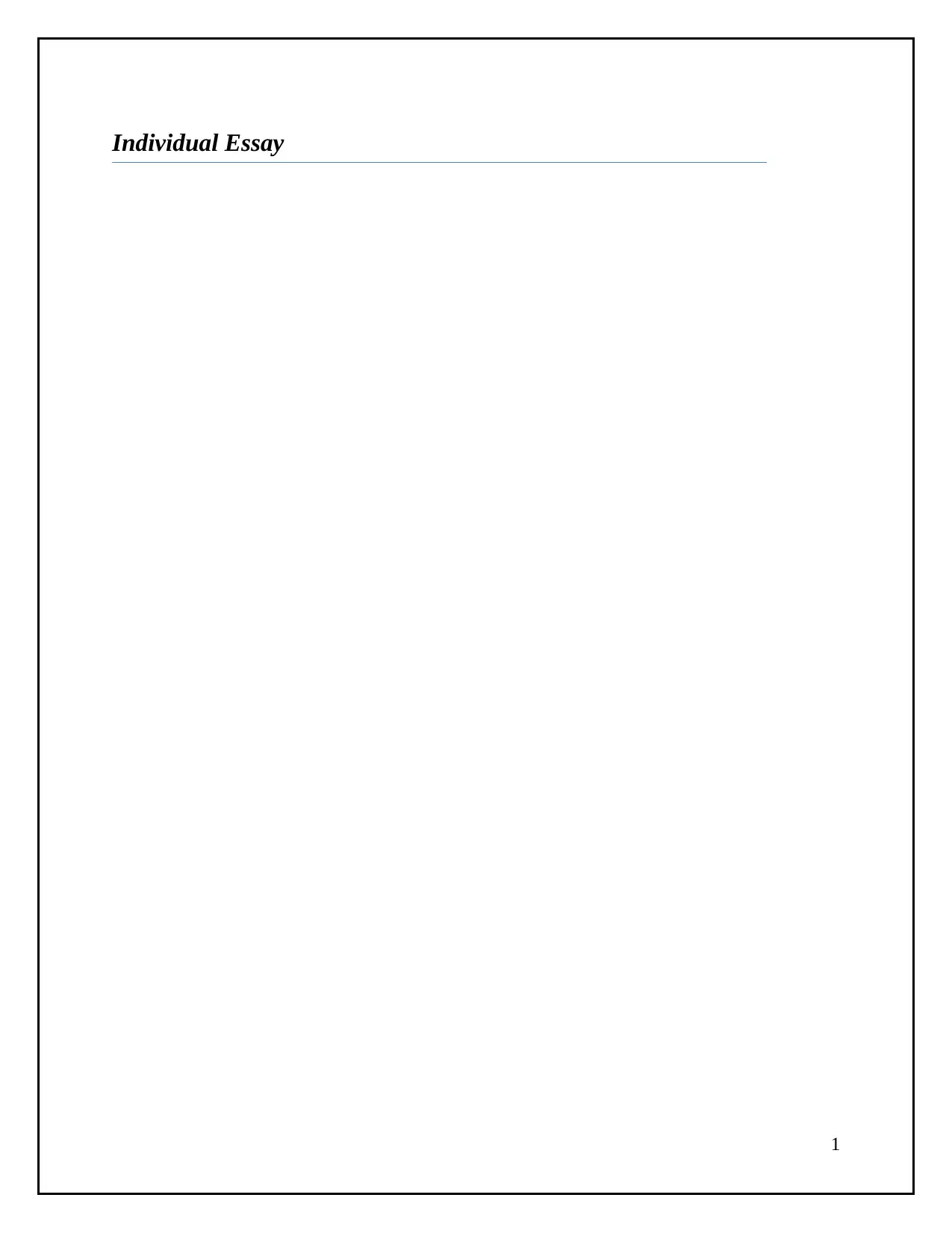
Individual Essay
1
1
Paraphrase This Document
Need a fresh take? Get an instant paraphrase of this document with our AI Paraphraser
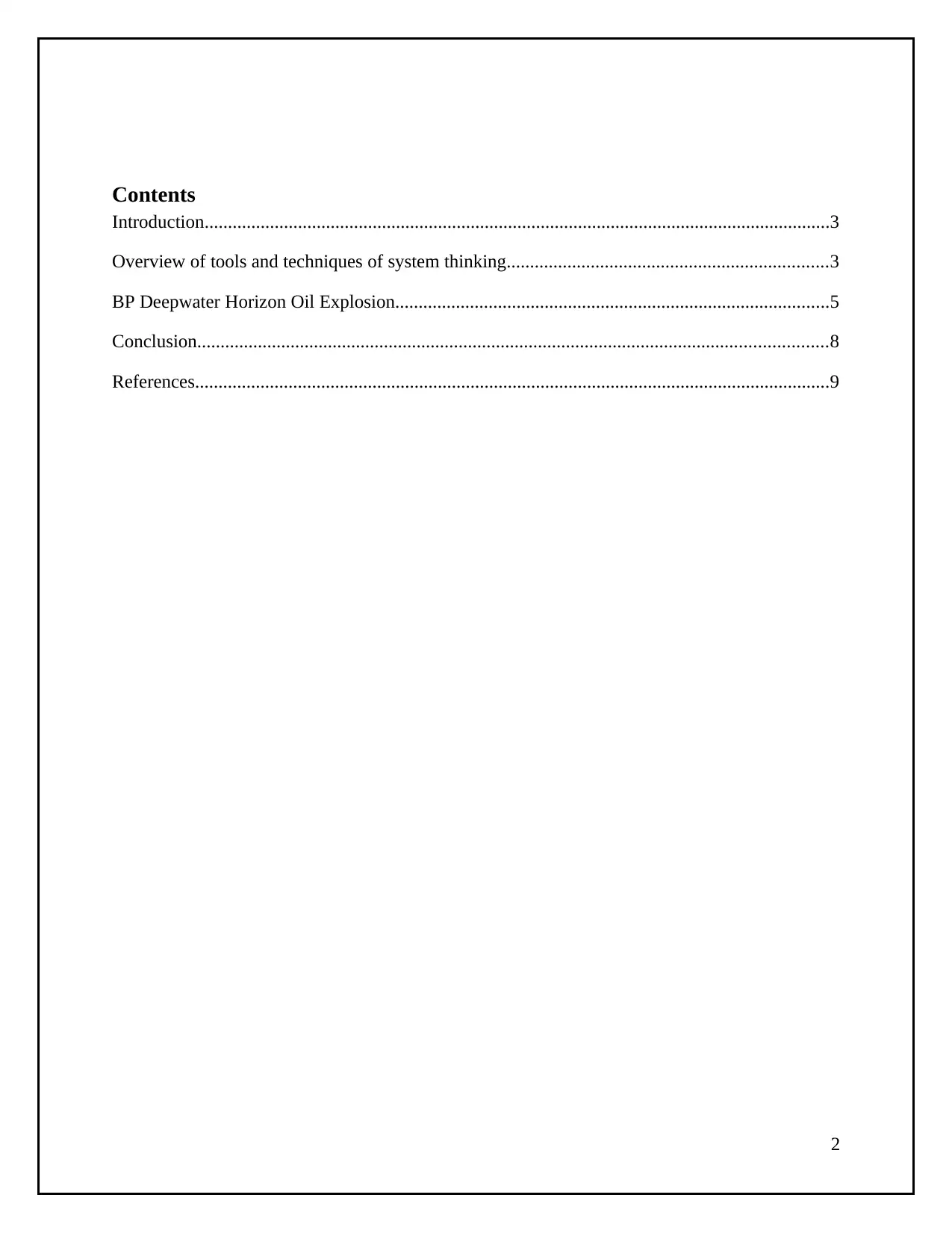
Contents
Introduction......................................................................................................................................3
Overview of tools and techniques of system thinking.....................................................................3
BP Deepwater Horizon Oil Explosion.............................................................................................5
Conclusion.......................................................................................................................................8
References........................................................................................................................................9
2
Introduction......................................................................................................................................3
Overview of tools and techniques of system thinking.....................................................................3
BP Deepwater Horizon Oil Explosion.............................................................................................5
Conclusion.......................................................................................................................................8
References........................................................................................................................................9
2
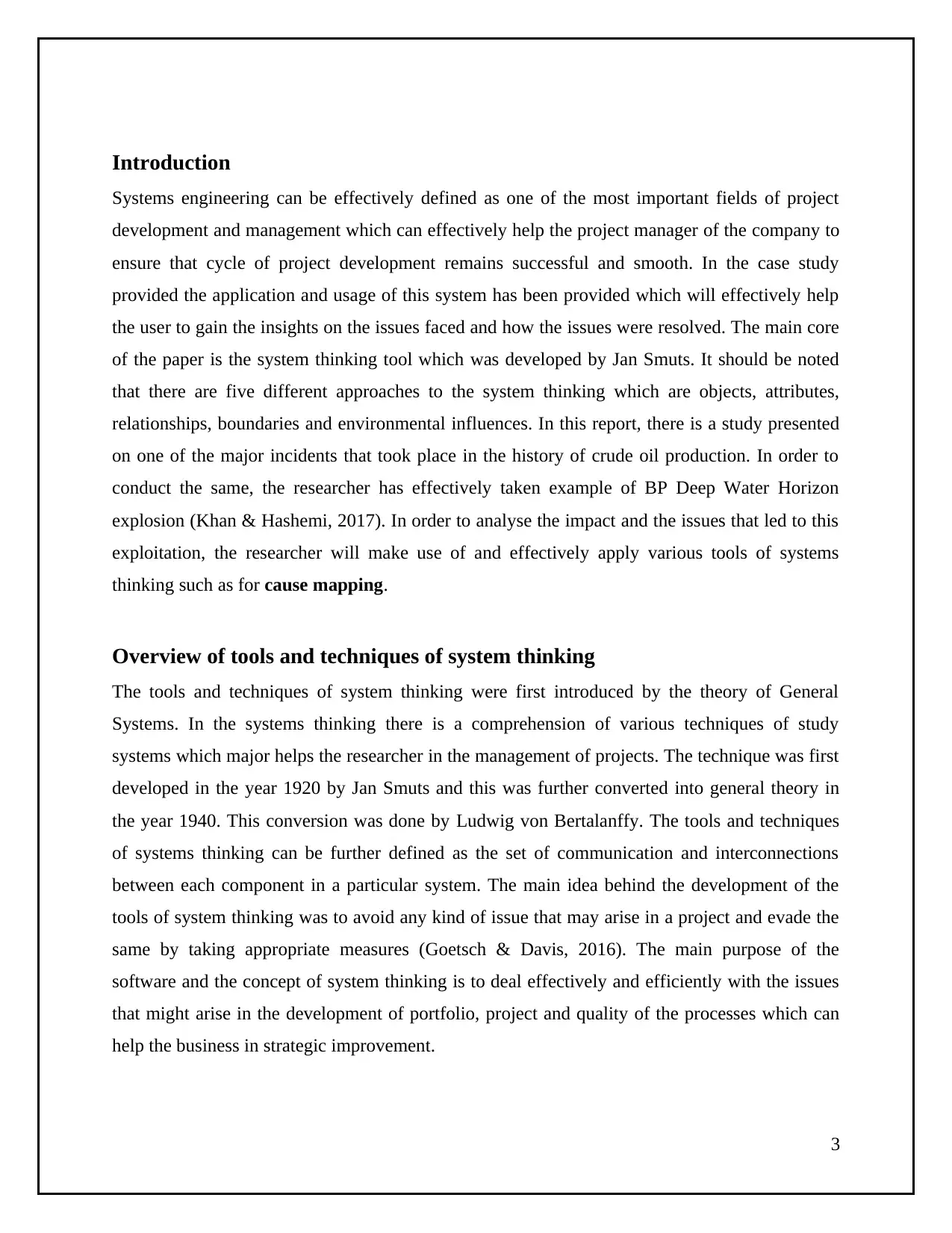
Introduction
Systems engineering can be effectively defined as one of the most important fields of project
development and management which can effectively help the project manager of the company to
ensure that cycle of project development remains successful and smooth. In the case study
provided the application and usage of this system has been provided which will effectively help
the user to gain the insights on the issues faced and how the issues were resolved. The main core
of the paper is the system thinking tool which was developed by Jan Smuts. It should be noted
that there are five different approaches to the system thinking which are objects, attributes,
relationships, boundaries and environmental influences. In this report, there is a study presented
on one of the major incidents that took place in the history of crude oil production. In order to
conduct the same, the researcher has effectively taken example of BP Deep Water Horizon
explosion (Khan & Hashemi, 2017). In order to analyse the impact and the issues that led to this
exploitation, the researcher will make use of and effectively apply various tools of systems
thinking such as for cause mapping.
Overview of tools and techniques of system thinking
The tools and techniques of system thinking were first introduced by the theory of General
Systems. In the systems thinking there is a comprehension of various techniques of study
systems which major helps the researcher in the management of projects. The technique was first
developed in the year 1920 by Jan Smuts and this was further converted into general theory in
the year 1940. This conversion was done by Ludwig von Bertalanffy. The tools and techniques
of systems thinking can be further defined as the set of communication and interconnections
between each component in a particular system. The main idea behind the development of the
tools of system thinking was to avoid any kind of issue that may arise in a project and evade the
same by taking appropriate measures (Goetsch & Davis, 2016). The main purpose of the
software and the concept of system thinking is to deal effectively and efficiently with the issues
that might arise in the development of portfolio, project and quality of the processes which can
help the business in strategic improvement.
3
Systems engineering can be effectively defined as one of the most important fields of project
development and management which can effectively help the project manager of the company to
ensure that cycle of project development remains successful and smooth. In the case study
provided the application and usage of this system has been provided which will effectively help
the user to gain the insights on the issues faced and how the issues were resolved. The main core
of the paper is the system thinking tool which was developed by Jan Smuts. It should be noted
that there are five different approaches to the system thinking which are objects, attributes,
relationships, boundaries and environmental influences. In this report, there is a study presented
on one of the major incidents that took place in the history of crude oil production. In order to
conduct the same, the researcher has effectively taken example of BP Deep Water Horizon
explosion (Khan & Hashemi, 2017). In order to analyse the impact and the issues that led to this
exploitation, the researcher will make use of and effectively apply various tools of systems
thinking such as for cause mapping.
Overview of tools and techniques of system thinking
The tools and techniques of system thinking were first introduced by the theory of General
Systems. In the systems thinking there is a comprehension of various techniques of study
systems which major helps the researcher in the management of projects. The technique was first
developed in the year 1920 by Jan Smuts and this was further converted into general theory in
the year 1940. This conversion was done by Ludwig von Bertalanffy. The tools and techniques
of systems thinking can be further defined as the set of communication and interconnections
between each component in a particular system. The main idea behind the development of the
tools of system thinking was to avoid any kind of issue that may arise in a project and evade the
same by taking appropriate measures (Goetsch & Davis, 2016). The main purpose of the
software and the concept of system thinking is to deal effectively and efficiently with the issues
that might arise in the development of portfolio, project and quality of the processes which can
help the business in strategic improvement.
3
⊘ This is a preview!⊘
Do you want full access?
Subscribe today to unlock all pages.

Trusted by 1+ million students worldwide
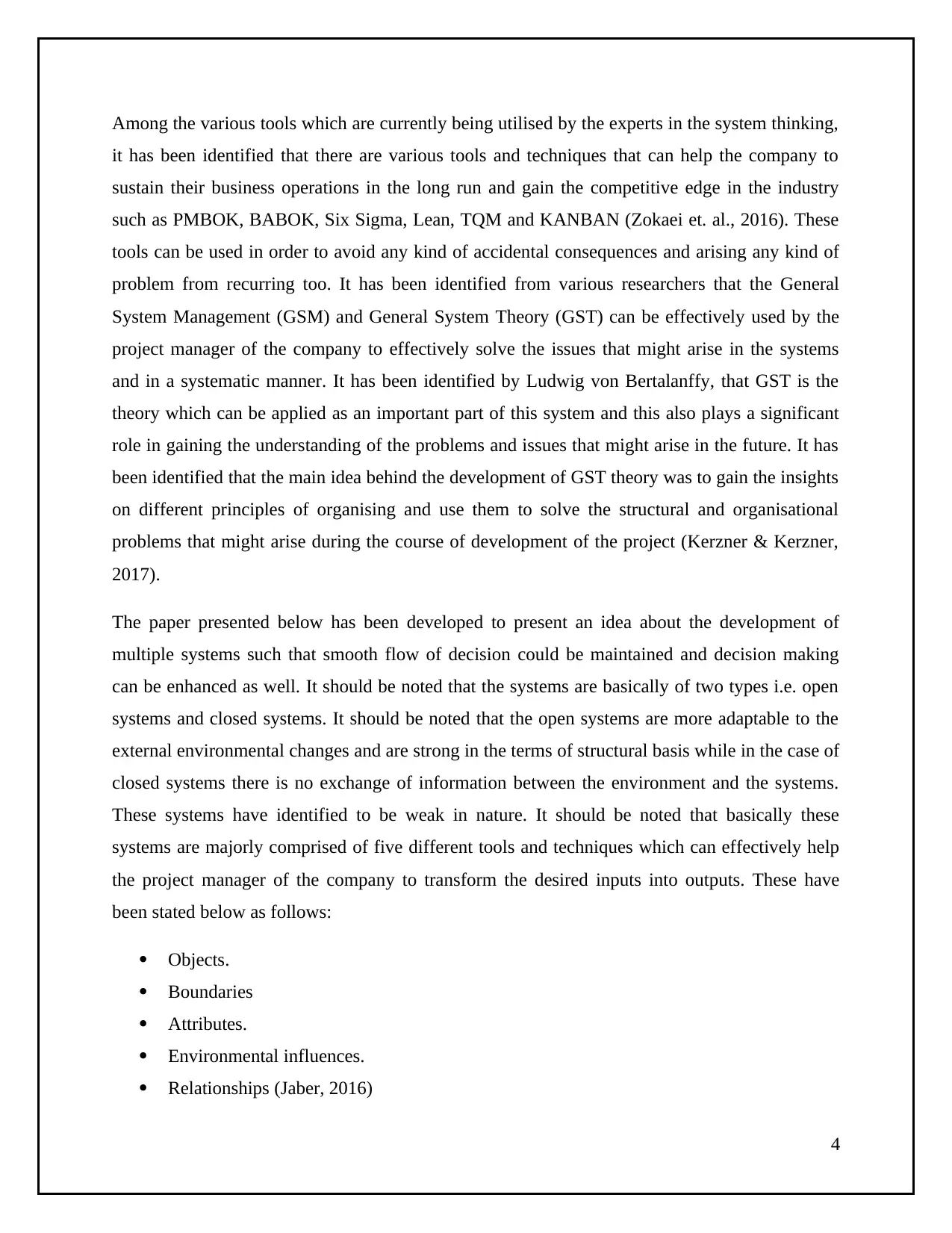
Among the various tools which are currently being utilised by the experts in the system thinking,
it has been identified that there are various tools and techniques that can help the company to
sustain their business operations in the long run and gain the competitive edge in the industry
such as PMBOK, BABOK, Six Sigma, Lean, TQM and KANBAN (Zokaei et. al., 2016). These
tools can be used in order to avoid any kind of accidental consequences and arising any kind of
problem from recurring too. It has been identified from various researchers that the General
System Management (GSM) and General System Theory (GST) can be effectively used by the
project manager of the company to effectively solve the issues that might arise in the systems
and in a systematic manner. It has been identified by Ludwig von Bertalanffy, that GST is the
theory which can be applied as an important part of this system and this also plays a significant
role in gaining the understanding of the problems and issues that might arise in the future. It has
been identified that the main idea behind the development of GST theory was to gain the insights
on different principles of organising and use them to solve the structural and organisational
problems that might arise during the course of development of the project (Kerzner & Kerzner,
2017).
The paper presented below has been developed to present an idea about the development of
multiple systems such that smooth flow of decision could be maintained and decision making
can be enhanced as well. It should be noted that the systems are basically of two types i.e. open
systems and closed systems. It should be noted that the open systems are more adaptable to the
external environmental changes and are strong in the terms of structural basis while in the case of
closed systems there is no exchange of information between the environment and the systems.
These systems have identified to be weak in nature. It should be noted that basically these
systems are majorly comprised of five different tools and techniques which can effectively help
the project manager of the company to transform the desired inputs into outputs. These have
been stated below as follows:
Objects.
Boundaries
Attributes.
Environmental influences.
Relationships (Jaber, 2016)
4
it has been identified that there are various tools and techniques that can help the company to
sustain their business operations in the long run and gain the competitive edge in the industry
such as PMBOK, BABOK, Six Sigma, Lean, TQM and KANBAN (Zokaei et. al., 2016). These
tools can be used in order to avoid any kind of accidental consequences and arising any kind of
problem from recurring too. It has been identified from various researchers that the General
System Management (GSM) and General System Theory (GST) can be effectively used by the
project manager of the company to effectively solve the issues that might arise in the systems
and in a systematic manner. It has been identified by Ludwig von Bertalanffy, that GST is the
theory which can be applied as an important part of this system and this also plays a significant
role in gaining the understanding of the problems and issues that might arise in the future. It has
been identified that the main idea behind the development of GST theory was to gain the insights
on different principles of organising and use them to solve the structural and organisational
problems that might arise during the course of development of the project (Kerzner & Kerzner,
2017).
The paper presented below has been developed to present an idea about the development of
multiple systems such that smooth flow of decision could be maintained and decision making
can be enhanced as well. It should be noted that the systems are basically of two types i.e. open
systems and closed systems. It should be noted that the open systems are more adaptable to the
external environmental changes and are strong in the terms of structural basis while in the case of
closed systems there is no exchange of information between the environment and the systems.
These systems have identified to be weak in nature. It should be noted that basically these
systems are majorly comprised of five different tools and techniques which can effectively help
the project manager of the company to transform the desired inputs into outputs. These have
been stated below as follows:
Objects.
Boundaries
Attributes.
Environmental influences.
Relationships (Jaber, 2016)
4
Paraphrase This Document
Need a fresh take? Get an instant paraphrase of this document with our AI Paraphraser
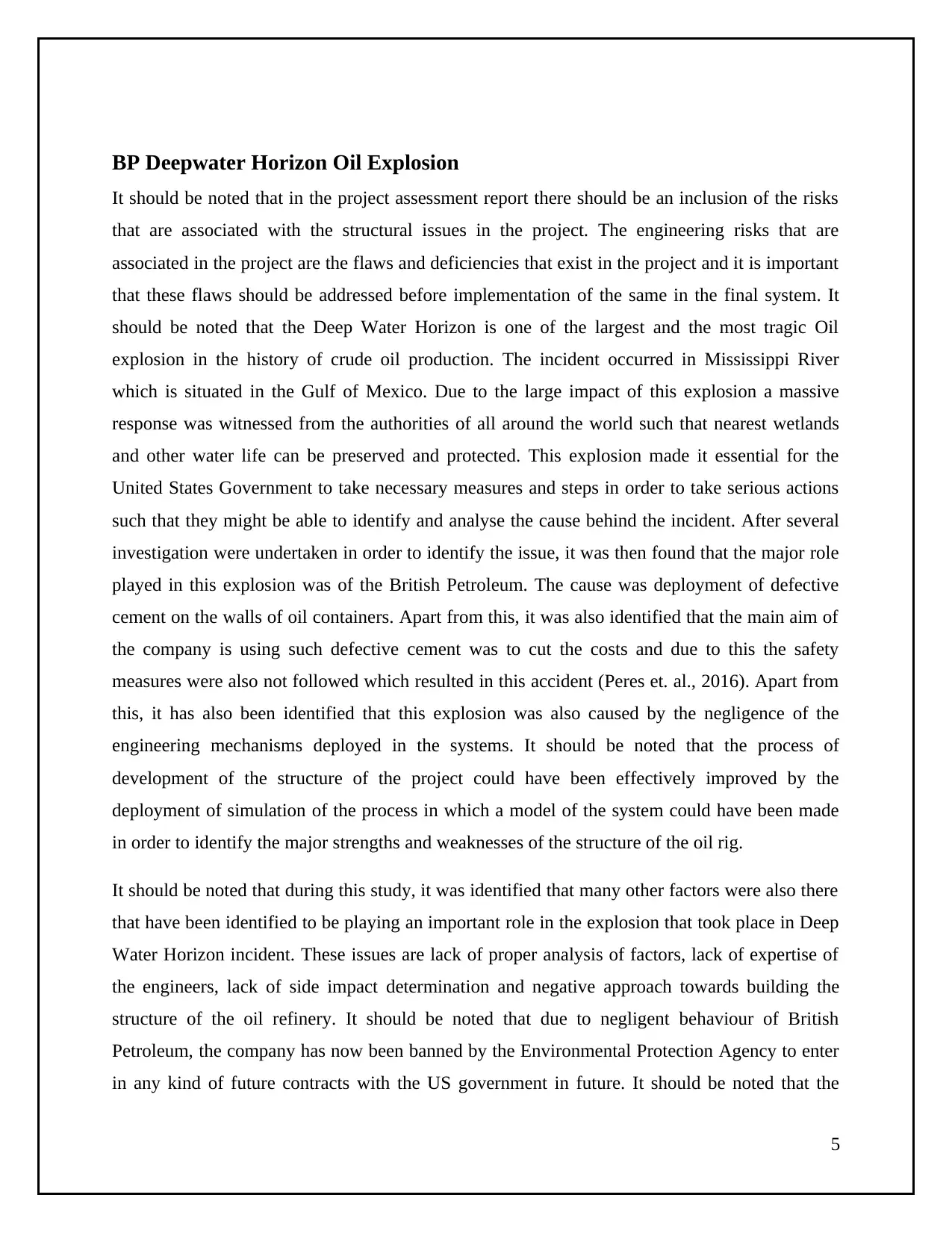
BP Deepwater Horizon Oil Explosion
It should be noted that in the project assessment report there should be an inclusion of the risks
that are associated with the structural issues in the project. The engineering risks that are
associated in the project are the flaws and deficiencies that exist in the project and it is important
that these flaws should be addressed before implementation of the same in the final system. It
should be noted that the Deep Water Horizon is one of the largest and the most tragic Oil
explosion in the history of crude oil production. The incident occurred in Mississippi River
which is situated in the Gulf of Mexico. Due to the large impact of this explosion a massive
response was witnessed from the authorities of all around the world such that nearest wetlands
and other water life can be preserved and protected. This explosion made it essential for the
United States Government to take necessary measures and steps in order to take serious actions
such that they might be able to identify and analyse the cause behind the incident. After several
investigation were undertaken in order to identify the issue, it was then found that the major role
played in this explosion was of the British Petroleum. The cause was deployment of defective
cement on the walls of oil containers. Apart from this, it was also identified that the main aim of
the company is using such defective cement was to cut the costs and due to this the safety
measures were also not followed which resulted in this accident (Peres et. al., 2016). Apart from
this, it has also been identified that this explosion was also caused by the negligence of the
engineering mechanisms deployed in the systems. It should be noted that the process of
development of the structure of the project could have been effectively improved by the
deployment of simulation of the process in which a model of the system could have been made
in order to identify the major strengths and weaknesses of the structure of the oil rig.
It should be noted that during this study, it was identified that many other factors were also there
that have been identified to be playing an important role in the explosion that took place in Deep
Water Horizon incident. These issues are lack of proper analysis of factors, lack of expertise of
the engineers, lack of side impact determination and negative approach towards building the
structure of the oil refinery. It should be noted that due to negligent behaviour of British
Petroleum, the company has now been banned by the Environmental Protection Agency to enter
in any kind of future contracts with the US government in future. It should be noted that the
5
It should be noted that in the project assessment report there should be an inclusion of the risks
that are associated with the structural issues in the project. The engineering risks that are
associated in the project are the flaws and deficiencies that exist in the project and it is important
that these flaws should be addressed before implementation of the same in the final system. It
should be noted that the Deep Water Horizon is one of the largest and the most tragic Oil
explosion in the history of crude oil production. The incident occurred in Mississippi River
which is situated in the Gulf of Mexico. Due to the large impact of this explosion a massive
response was witnessed from the authorities of all around the world such that nearest wetlands
and other water life can be preserved and protected. This explosion made it essential for the
United States Government to take necessary measures and steps in order to take serious actions
such that they might be able to identify and analyse the cause behind the incident. After several
investigation were undertaken in order to identify the issue, it was then found that the major role
played in this explosion was of the British Petroleum. The cause was deployment of defective
cement on the walls of oil containers. Apart from this, it was also identified that the main aim of
the company is using such defective cement was to cut the costs and due to this the safety
measures were also not followed which resulted in this accident (Peres et. al., 2016). Apart from
this, it has also been identified that this explosion was also caused by the negligence of the
engineering mechanisms deployed in the systems. It should be noted that the process of
development of the structure of the project could have been effectively improved by the
deployment of simulation of the process in which a model of the system could have been made
in order to identify the major strengths and weaknesses of the structure of the oil rig.
It should be noted that during this study, it was identified that many other factors were also there
that have been identified to be playing an important role in the explosion that took place in Deep
Water Horizon incident. These issues are lack of proper analysis of factors, lack of expertise of
the engineers, lack of side impact determination and negative approach towards building the
structure of the oil refinery. It should be noted that due to negligent behaviour of British
Petroleum, the company has now been banned by the Environmental Protection Agency to enter
in any kind of future contracts with the US government in future. It should be noted that the
5
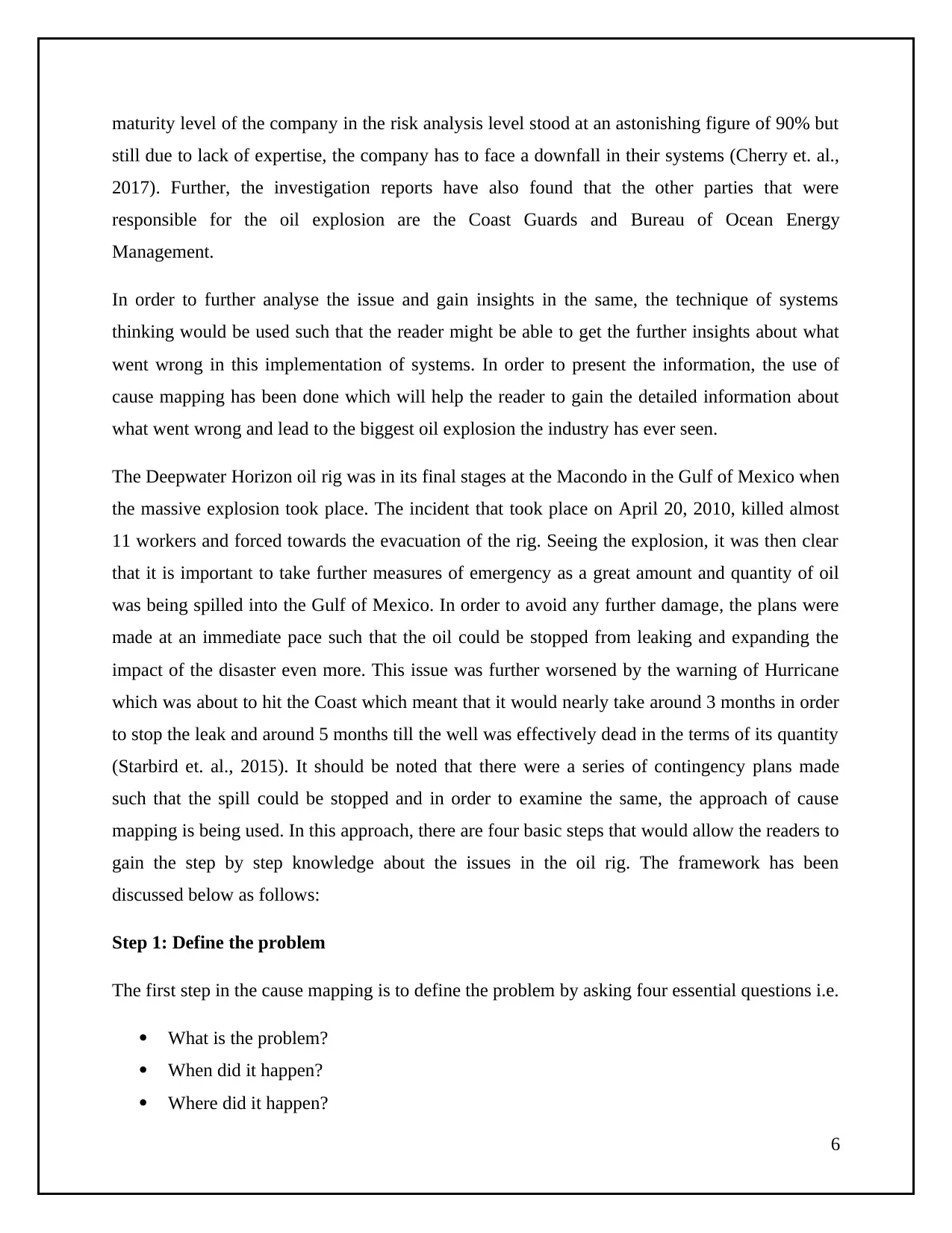
maturity level of the company in the risk analysis level stood at an astonishing figure of 90% but
still due to lack of expertise, the company has to face a downfall in their systems (Cherry et. al.,
2017). Further, the investigation reports have also found that the other parties that were
responsible for the oil explosion are the Coast Guards and Bureau of Ocean Energy
Management.
In order to further analyse the issue and gain insights in the same, the technique of systems
thinking would be used such that the reader might be able to get the further insights about what
went wrong in this implementation of systems. In order to present the information, the use of
cause mapping has been done which will help the reader to gain the detailed information about
what went wrong and lead to the biggest oil explosion the industry has ever seen.
The Deepwater Horizon oil rig was in its final stages at the Macondo in the Gulf of Mexico when
the massive explosion took place. The incident that took place on April 20, 2010, killed almost
11 workers and forced towards the evacuation of the rig. Seeing the explosion, it was then clear
that it is important to take further measures of emergency as a great amount and quantity of oil
was being spilled into the Gulf of Mexico. In order to avoid any further damage, the plans were
made at an immediate pace such that the oil could be stopped from leaking and expanding the
impact of the disaster even more. This issue was further worsened by the warning of Hurricane
which was about to hit the Coast which meant that it would nearly take around 3 months in order
to stop the leak and around 5 months till the well was effectively dead in the terms of its quantity
(Starbird et. al., 2015). It should be noted that there were a series of contingency plans made
such that the spill could be stopped and in order to examine the same, the approach of cause
mapping is being used. In this approach, there are four basic steps that would allow the readers to
gain the step by step knowledge about the issues in the oil rig. The framework has been
discussed below as follows:
Step 1: Define the problem
The first step in the cause mapping is to define the problem by asking four essential questions i.e.
What is the problem?
When did it happen?
Where did it happen?
6
still due to lack of expertise, the company has to face a downfall in their systems (Cherry et. al.,
2017). Further, the investigation reports have also found that the other parties that were
responsible for the oil explosion are the Coast Guards and Bureau of Ocean Energy
Management.
In order to further analyse the issue and gain insights in the same, the technique of systems
thinking would be used such that the reader might be able to get the further insights about what
went wrong in this implementation of systems. In order to present the information, the use of
cause mapping has been done which will help the reader to gain the detailed information about
what went wrong and lead to the biggest oil explosion the industry has ever seen.
The Deepwater Horizon oil rig was in its final stages at the Macondo in the Gulf of Mexico when
the massive explosion took place. The incident that took place on April 20, 2010, killed almost
11 workers and forced towards the evacuation of the rig. Seeing the explosion, it was then clear
that it is important to take further measures of emergency as a great amount and quantity of oil
was being spilled into the Gulf of Mexico. In order to avoid any further damage, the plans were
made at an immediate pace such that the oil could be stopped from leaking and expanding the
impact of the disaster even more. This issue was further worsened by the warning of Hurricane
which was about to hit the Coast which meant that it would nearly take around 3 months in order
to stop the leak and around 5 months till the well was effectively dead in the terms of its quantity
(Starbird et. al., 2015). It should be noted that there were a series of contingency plans made
such that the spill could be stopped and in order to examine the same, the approach of cause
mapping is being used. In this approach, there are four basic steps that would allow the readers to
gain the step by step knowledge about the issues in the oil rig. The framework has been
discussed below as follows:
Step 1: Define the problem
The first step in the cause mapping is to define the problem by asking four essential questions i.e.
What is the problem?
When did it happen?
Where did it happen?
6
⊘ This is a preview!⊘
Do you want full access?
Subscribe today to unlock all pages.

Trusted by 1+ million students worldwide
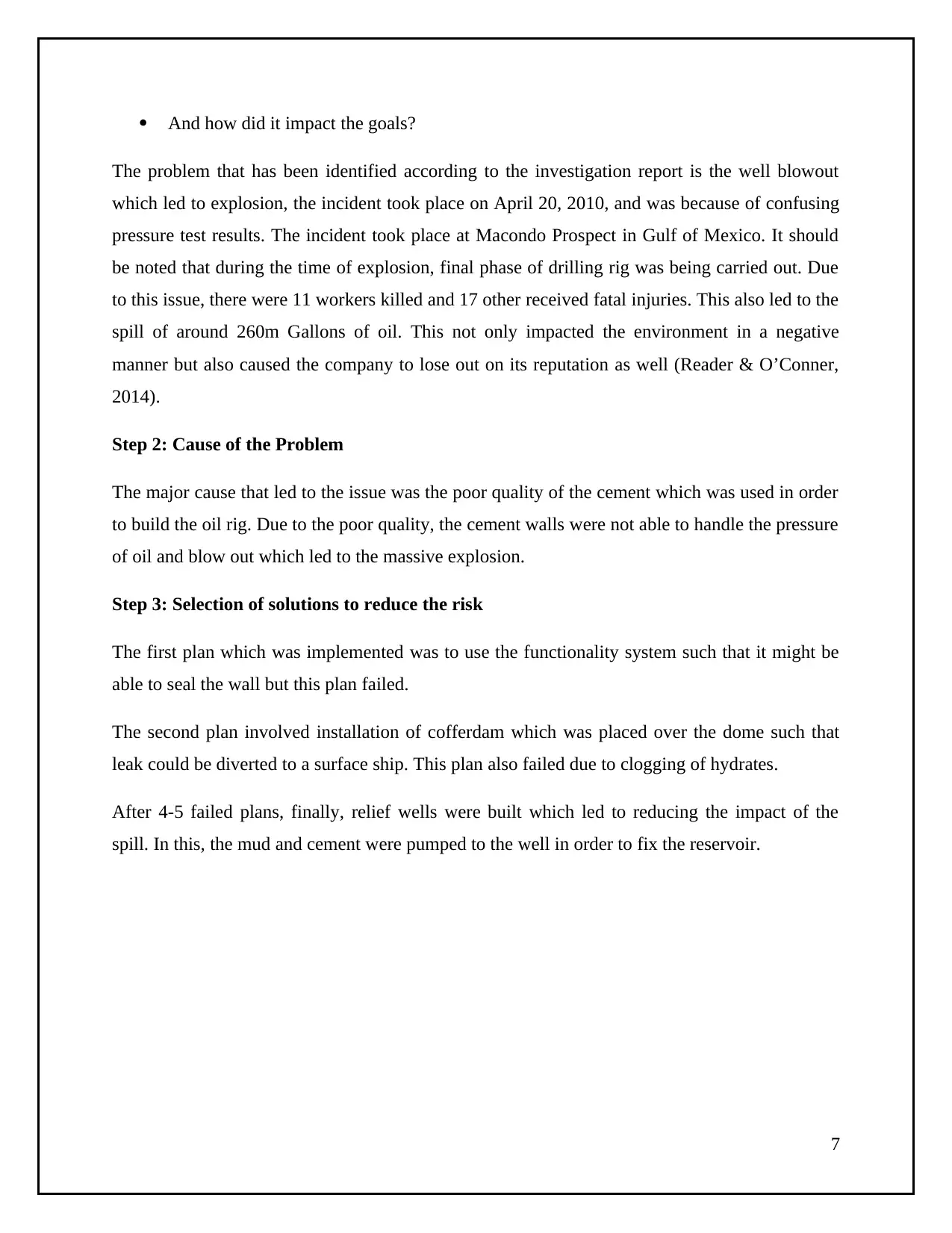
And how did it impact the goals?
The problem that has been identified according to the investigation report is the well blowout
which led to explosion, the incident took place on April 20, 2010, and was because of confusing
pressure test results. The incident took place at Macondo Prospect in Gulf of Mexico. It should
be noted that during the time of explosion, final phase of drilling rig was being carried out. Due
to this issue, there were 11 workers killed and 17 other received fatal injuries. This also led to the
spill of around 260m Gallons of oil. This not only impacted the environment in a negative
manner but also caused the company to lose out on its reputation as well (Reader & O’Conner,
2014).
Step 2: Cause of the Problem
The major cause that led to the issue was the poor quality of the cement which was used in order
to build the oil rig. Due to the poor quality, the cement walls were not able to handle the pressure
of oil and blow out which led to the massive explosion.
Step 3: Selection of solutions to reduce the risk
The first plan which was implemented was to use the functionality system such that it might be
able to seal the wall but this plan failed.
The second plan involved installation of cofferdam which was placed over the dome such that
leak could be diverted to a surface ship. This plan also failed due to clogging of hydrates.
After 4-5 failed plans, finally, relief wells were built which led to reducing the impact of the
spill. In this, the mud and cement were pumped to the well in order to fix the reservoir.
7
The problem that has been identified according to the investigation report is the well blowout
which led to explosion, the incident took place on April 20, 2010, and was because of confusing
pressure test results. The incident took place at Macondo Prospect in Gulf of Mexico. It should
be noted that during the time of explosion, final phase of drilling rig was being carried out. Due
to this issue, there were 11 workers killed and 17 other received fatal injuries. This also led to the
spill of around 260m Gallons of oil. This not only impacted the environment in a negative
manner but also caused the company to lose out on its reputation as well (Reader & O’Conner,
2014).
Step 2: Cause of the Problem
The major cause that led to the issue was the poor quality of the cement which was used in order
to build the oil rig. Due to the poor quality, the cement walls were not able to handle the pressure
of oil and blow out which led to the massive explosion.
Step 3: Selection of solutions to reduce the risk
The first plan which was implemented was to use the functionality system such that it might be
able to seal the wall but this plan failed.
The second plan involved installation of cofferdam which was placed over the dome such that
leak could be diverted to a surface ship. This plan also failed due to clogging of hydrates.
After 4-5 failed plans, finally, relief wells were built which led to reducing the impact of the
spill. In this, the mud and cement were pumped to the well in order to fix the reservoir.
7
Paraphrase This Document
Need a fresh take? Get an instant paraphrase of this document with our AI Paraphraser
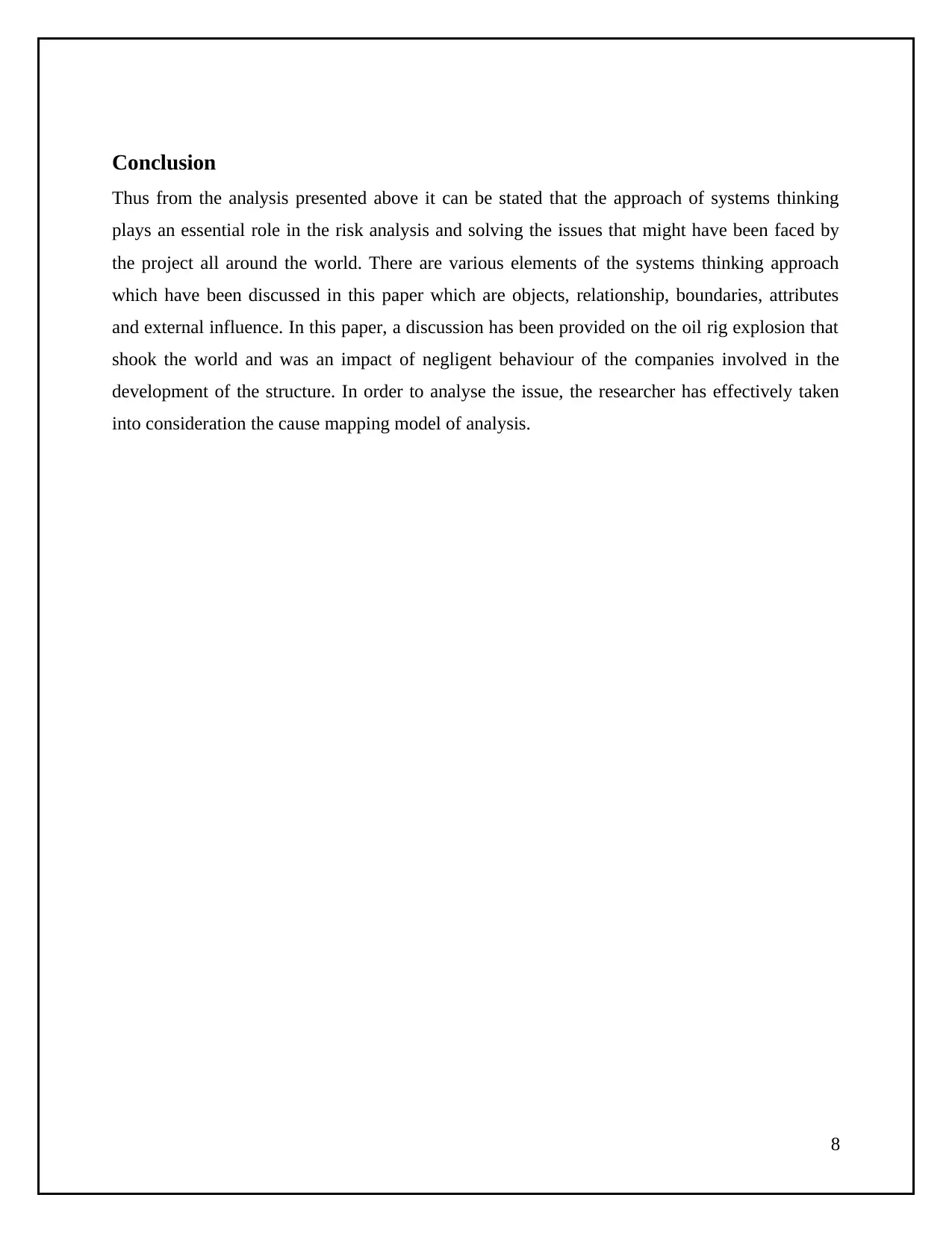
Conclusion
Thus from the analysis presented above it can be stated that the approach of systems thinking
plays an essential role in the risk analysis and solving the issues that might have been faced by
the project all around the world. There are various elements of the systems thinking approach
which have been discussed in this paper which are objects, relationship, boundaries, attributes
and external influence. In this paper, a discussion has been provided on the oil rig explosion that
shook the world and was an impact of negligent behaviour of the companies involved in the
development of the structure. In order to analyse the issue, the researcher has effectively taken
into consideration the cause mapping model of analysis.
8
Thus from the analysis presented above it can be stated that the approach of systems thinking
plays an essential role in the risk analysis and solving the issues that might have been faced by
the project all around the world. There are various elements of the systems thinking approach
which have been discussed in this paper which are objects, relationship, boundaries, attributes
and external influence. In this paper, a discussion has been provided on the oil rig explosion that
shook the world and was an impact of negligent behaviour of the companies involved in the
development of the structure. In order to analyse the issue, the researcher has effectively taken
into consideration the cause mapping model of analysis.
8
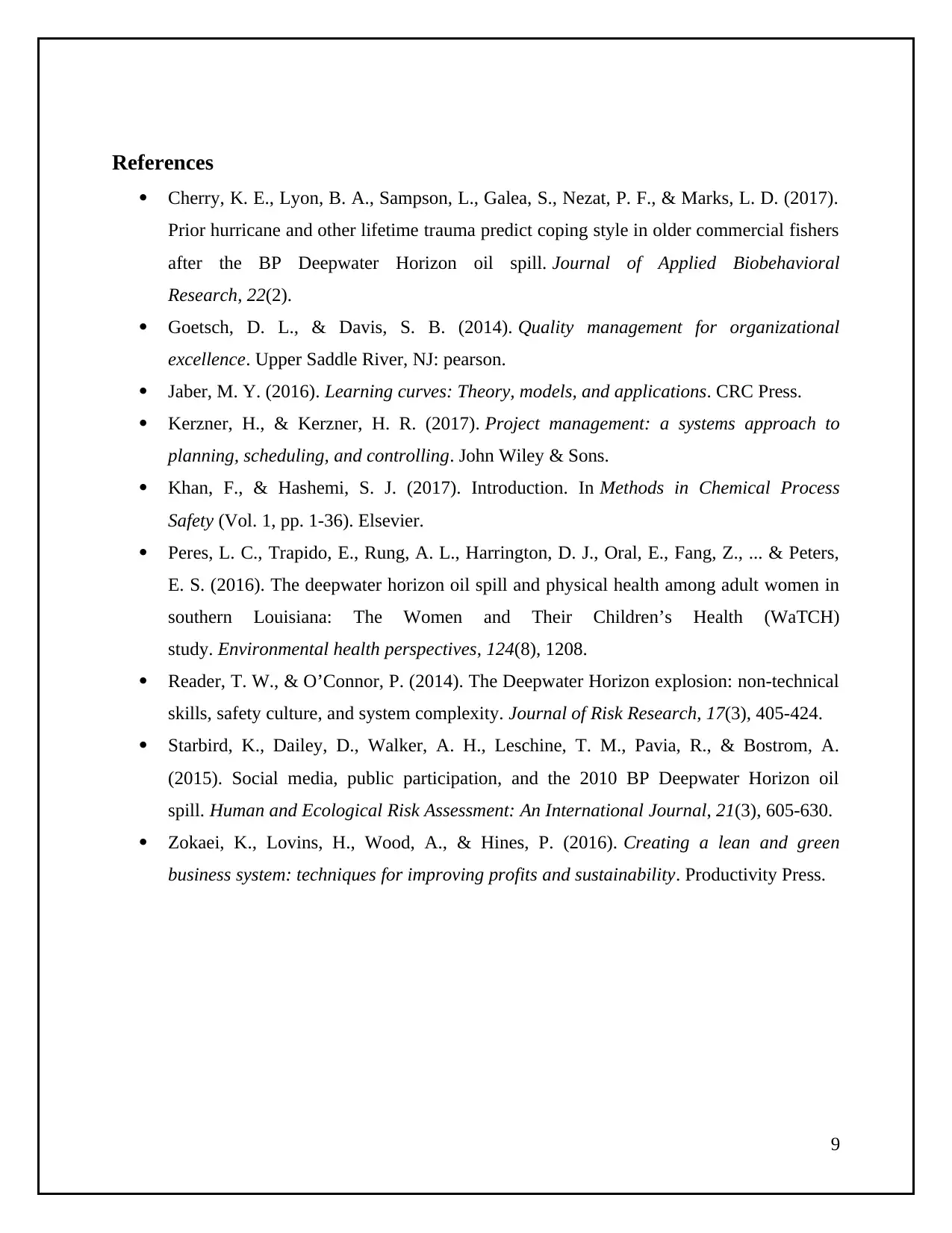
References
Cherry, K. E., Lyon, B. A., Sampson, L., Galea, S., Nezat, P. F., & Marks, L. D. (2017).
Prior hurricane and other lifetime trauma predict coping style in older commercial fishers
after the BP Deepwater Horizon oil spill. Journal of Applied Biobehavioral
Research, 22(2).
Goetsch, D. L., & Davis, S. B. (2014). Quality management for organizational
excellence. Upper Saddle River, NJ: pearson.
Jaber, M. Y. (2016). Learning curves: Theory, models, and applications. CRC Press.
Kerzner, H., & Kerzner, H. R. (2017). Project management: a systems approach to
planning, scheduling, and controlling. John Wiley & Sons.
Khan, F., & Hashemi, S. J. (2017). Introduction. In Methods in Chemical Process
Safety (Vol. 1, pp. 1-36). Elsevier.
Peres, L. C., Trapido, E., Rung, A. L., Harrington, D. J., Oral, E., Fang, Z., ... & Peters,
E. S. (2016). The deepwater horizon oil spill and physical health among adult women in
southern Louisiana: The Women and Their Children’s Health (WaTCH)
study. Environmental health perspectives, 124(8), 1208.
Reader, T. W., & O’Connor, P. (2014). The Deepwater Horizon explosion: non-technical
skills, safety culture, and system complexity. Journal of Risk Research, 17(3), 405-424.
Starbird, K., Dailey, D., Walker, A. H., Leschine, T. M., Pavia, R., & Bostrom, A.
(2015). Social media, public participation, and the 2010 BP Deepwater Horizon oil
spill. Human and Ecological Risk Assessment: An International Journal, 21(3), 605-630.
Zokaei, K., Lovins, H., Wood, A., & Hines, P. (2016). Creating a lean and green
business system: techniques for improving profits and sustainability. Productivity Press.
9
Cherry, K. E., Lyon, B. A., Sampson, L., Galea, S., Nezat, P. F., & Marks, L. D. (2017).
Prior hurricane and other lifetime trauma predict coping style in older commercial fishers
after the BP Deepwater Horizon oil spill. Journal of Applied Biobehavioral
Research, 22(2).
Goetsch, D. L., & Davis, S. B. (2014). Quality management for organizational
excellence. Upper Saddle River, NJ: pearson.
Jaber, M. Y. (2016). Learning curves: Theory, models, and applications. CRC Press.
Kerzner, H., & Kerzner, H. R. (2017). Project management: a systems approach to
planning, scheduling, and controlling. John Wiley & Sons.
Khan, F., & Hashemi, S. J. (2017). Introduction. In Methods in Chemical Process
Safety (Vol. 1, pp. 1-36). Elsevier.
Peres, L. C., Trapido, E., Rung, A. L., Harrington, D. J., Oral, E., Fang, Z., ... & Peters,
E. S. (2016). The deepwater horizon oil spill and physical health among adult women in
southern Louisiana: The Women and Their Children’s Health (WaTCH)
study. Environmental health perspectives, 124(8), 1208.
Reader, T. W., & O’Connor, P. (2014). The Deepwater Horizon explosion: non-technical
skills, safety culture, and system complexity. Journal of Risk Research, 17(3), 405-424.
Starbird, K., Dailey, D., Walker, A. H., Leschine, T. M., Pavia, R., & Bostrom, A.
(2015). Social media, public participation, and the 2010 BP Deepwater Horizon oil
spill. Human and Ecological Risk Assessment: An International Journal, 21(3), 605-630.
Zokaei, K., Lovins, H., Wood, A., & Hines, P. (2016). Creating a lean and green
business system: techniques for improving profits and sustainability. Productivity Press.
9
⊘ This is a preview!⊘
Do you want full access?
Subscribe today to unlock all pages.

Trusted by 1+ million students worldwide
1 out of 9
Related Documents
Your All-in-One AI-Powered Toolkit for Academic Success.
+13062052269
info@desklib.com
Available 24*7 on WhatsApp / Email
![[object Object]](/_next/static/media/star-bottom.7253800d.svg)
Unlock your academic potential
Copyright © 2020–2025 A2Z Services. All Rights Reserved. Developed and managed by ZUCOL.





